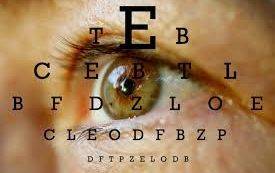Age related macular degeneration or ARMD is the most common cause of irreversible vision loss for people over the age of 60. It is estimated that 2.5 million people in developed countries will suffer visual loss from this disorder and that there are approximately 200,000 new cases diagnosed every year.
Macular degeneration is most common in people over the age of 65 but there have been some cases affecting people as young as their 40s and 50s. Symptoms include blurry or fuzzy vision, straight lines like telephone poles and sides of buildings appear wavy and a dark or empty area may appear in the center of vision.
What is the Macula?
The macula is the small portion of the retina located at the center of this light sensitive lining at the back of the eye. Light rays from objects that we are looking at come to a focus on the retina and are converted into electrical impulses that are then sent to the brain. The macula is responsible for sharp straight-ahead vision necessary for functions such as reading, driving a car and recognizing faces.
The effect of this disease can range from mild vision loss to central blindness. That is, blindness "straight ahead" but with normal peripheral vision from the non-macular part of the retina which is undamaged by the disease.
Two types of Macular Degeneration
Ninety percent of ARMD is of the "atrophic" or "dry" variety. It is characterized by a thinning of the macular tissue and the development of small deposits on the retina called drusen. Dry ARMD develops slowly and usually causes mild visual loss. The main symptom is often a dimming of vision when reading.
The second form of ARMD is called "exudative" or "wet" because of the abnormal growth of new blood vessels under the macula where they leak and eventually create a large blind spot in the central vision. This form of the disease is of much greater threat to vision than the more common dry type.
What are the causes of ARMD?
Unfortunately, the cause of this eye condition is not fully understood but it is associated with the aging process. As we age, we become more susceptible to numerous degenerative processes like arthritis, heart conditions, cancer, cataracts and macular degeneration. These conditions may be caused by the body's overproduction of free radicals.
During the metabolic process, oxygen atoms with an extra electron are released. These extra electrons are quite destructive and cause cellular damage, alter DNA, and are thought to be at least partially responsible for many of the degenerative diseases mentioned above. The production of these free radicals is normal during metabolism but the body produces its own "anti-oxidants" to neutralize them.
Some of the vitamins in the food we eat also have anti-oxidant properties. These are vitamins A, C, E and beta-carotene. Unfortunately, smoking, poor nutrition and other lifestyle factors result in the body producing too many free radicals. For this reason, lifestyle factors may contribute to the risk of ARMD.
There is some evidence to suggest that ARMD has a genetic basis, as the condition tends to run in families. The exact nature of this familial tendency, however, has not been clarified. It has been suggested from twin studies that there is a defect in the genes responsible for the integrity and health of the retina.
Exposure to certain types of light may also play a role. Studies performed on fishermen in the Chesapeake Bay suggest that long-term exposure to ultraviolet light from the sun may increase the risk of ARMD and other eye conditions such as the development of cataracts
It has also been hypothesized that hyperopia or farsightedness may also play a role in the development of the disease. It is thought that the shortening of the eye in hyperopia may cause changes in the membrane below the macula and in its blood vessels.
In the dry form of the disease, some form of inflammation may also be a factor although what causes the inflammation is not known.
How is it treated?
lthough researchers are spending a great deal of time investigating the cause and treatment of ARMD, there is no real cure available. The goal of current treatment efforts is to attempt to stabilize the condition.
For the more severe wet form of the disease, doctors have tried laser photocoagulation. This treatment, however, is not without dangers and is only beneficial in the very early stages of the condition, which is why early detection is so important. This technique involves directing a beam of laser light at the abnormal blood vessels in order to destroy them and prevent their leaking. Provided that the blood vessels have not grown under the macula, this treatment can be helpful in arresting the progress of the disease. If the blood vessels are already under the macula, the laser may cause scarring and permanent vision loss.
Several new treatments are under development and scientific evaluation.
A new type of treatment called photodynamic shows promise. A drug, injected into the arm travels to the affected eye and is then exposed to a non-thermal red light. This light activates the drug to close and seal off the abnormal blood vessels. The entire treatment only takes about 30 minutes and requires no anesthetic.
Treatment using proton beams, which release power at predetermined target site and depth, has also been experimentally tested for treatment of wet-ARMD.
Are Vitamins and Nutrition Useful?
No treatment exists for the dry form but many doctors are convinced that a combination of specific vitamins and minerals helps slow the progression of the disease. This has yet to be confirmed scientifically but there are valid reasons for attempting this therapy. Anti-oxidant vitamins may help to neutralize the free radicals that are associated with this degenerative process. Zinc, one of the most common trace minerals in our body, is highly concentrated in the retina and surrounding tissues and is a requirement for chemical reactions in the retina.
Fat-soluble anti-oxidant vitamins like vitamin A and vitamin E are stored in the body and can increase to toxic levels if over used and zinc may interfere with other trace minerals like copper. Caution should therefore be exercised in the use of vitamins and minerals.


